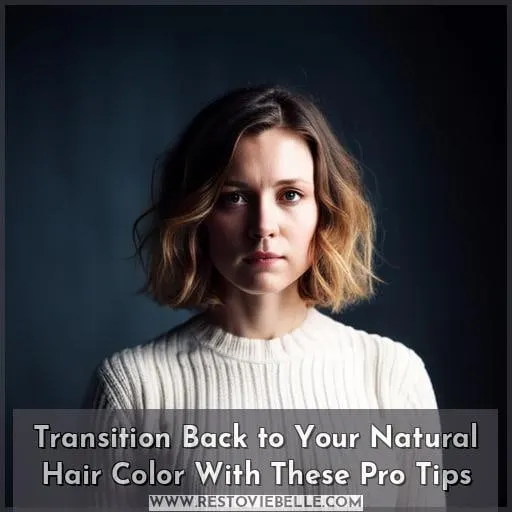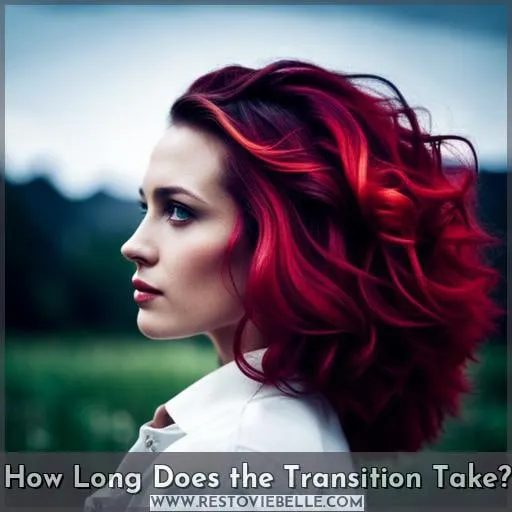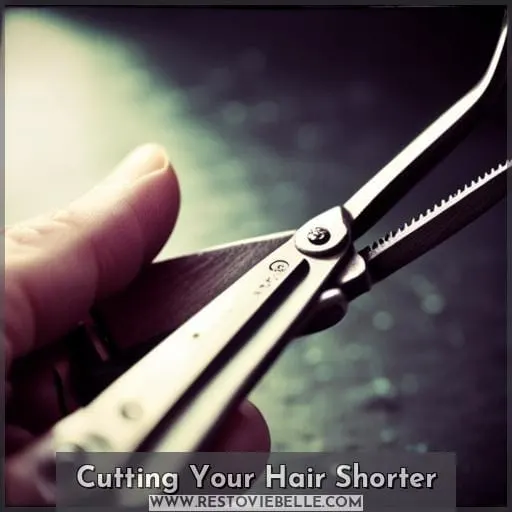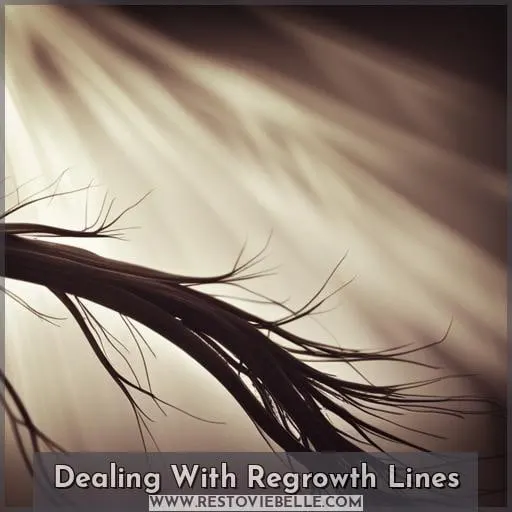This site is supported by our readers. We may earn a commission, at no cost to you, if you purchase through links.
 You’re not the only one wanting to go back to your roots. Research shows over 75% of women who color their hair eventually long for their natural hue again.
You’re not the only one wanting to go back to your roots. Research shows over 75% of women who color their hair eventually long for their natural hue again.
Taking that liberating leap back to your natural color can feel intimidating. But you don’t have to do it alone! With the right tips and techniques from trusted hair care experts, you can gracefully transition your locks back to their origins.
The journey requires patience and TLC as you slowly fade color or strategically trim away the dyed portions. But embracing your authentic shade is so rewarding – you’ll uncover depth, dimension and shine you didn’t know your hair possessed.
So whatever your reasons for going natural, take a deep breath and trust the process. With commitment and care, your hair will bloom even more beautifully in its original form.
Now let’s explore the path back to the color you were born to rock!
Table Of Contents
- Key Takeaways
- Removing Color From Your Hair
- How Long Does the Transition Take?
- Transitioning Strategies
- Pros and Cons of Going Natural
- Keeping Hair Healthy During Transition
- Cutting Your Hair Shorter
- Dealing With Regrowth Lines
- Highlights and Lowlights
- Embracing Your Grays
- Have Patience and Trust the Process
- Frequently Asked Questions (FAQs)
- Conclusion
Key Takeaways
- Allowing semi-permanent dye to fade out gradually with natural regrowth allows for a gradual transition to natural color.
- Shorter hairstyles and regular trims speed up the process by removing more of the colored ends.
- Protect and nourish hair during the transition with gentle shampoos, conditioners, and protective styling.
- Have patience during the process, allowing about 1/2 inch of new growth per month. Trust the timeline of the transition.
Removing Color From Your Hair
To truly return to your natural hair color, you must understand the differences between semi-permanent and permanent dye. Dish soap and vitamin C treatment work for semi-permanent color, however permanent dye requires more powerful removers like color fixers, bleach baths, or seeing a professional stylist.
Semi-Permanent Vs Permanent
You’re better off letting semi-permanent color fade naturally versus trying to remove permanent color yourself.
- Semi-permanent color fades in 4-6 weeks with clarifying shampoo.
- Permanent color won’t budge without bleach or dye remover.
- Removing permanent color risks hair damage if not done properly.
- Consult a professional colorist for permanent color removal.
- Letting semi-permanent color fade gradually is the safest option.
Transitioning back to your natural hair color requires patience and care. Semi-permanent dyes fade over time, while permanent color needs professional assistance.
Dye Removal Methods
Let’s look at bleaching first to lift out the artificial pigment. Stripping color with a clarifying shampoo helps fade tones gradually. Consider professional color removal treatments for challenging stains. Vitamin C mixed into conditioner can help extract unwanted hues over time.
Dish soap strips some temporary colors, but be cautious using household cleaners.
How Long Does the Transition Take?
So you’ve started the journey back to your gorgeous natural locks. Now comes the test of patience. Growing out color can feel like an eternity, but have faith – you’ll get there. Anticipate about 1⁄2 inch of new growth per month.
Regular progress checks keep motivation high. While transitioning, maintain moisture and protect those strands.
The awkward in-between stage can be a challenge, but focus on the finish line. Embrace the journey to let your true, beautiful hue shine through again.
- Measure growth monthly
- Moisturize diligently
- Try new styles
- Celebrate small wins
Transitioning Strategies
Hello, managing the transition back to your natural hair color can require some patience and creativity. Growing out your current color is the most natural option, though you can also dye your hair back to match your original hue for a quicker fix.
This will help blend any multi-toned sections as your roots begin to grow in. While growing out your color, try using headbands and hair accessories to disguise the line of demarcation. Use volumizing shampoos and conditioners to help blend the tones together. Also, get trims regularly to cut off the colored ends while maintaining the length.
As your roots grow longer, you can begin to color just them to create a seamless grow-out. With some time and clever styling, you’ll make it through the awkward in-between stage and back to your gorgeous natural color.
Growing Out
Naturally reclaiming your original hair shade by allowing regrowth requires patience as your locks lengthen, likely taking several months before completely phasing out color-treated sections. Let your tresses thrive with some TLC as your roots emerge. Consider a stylish new cut or creative styling to complement the intriguing combination of hues during this transitional period.
Embrace shorter styles if you’re ready for a dramatic change. Or stick with your current length and experiment with braids, highlights, or accessories to distract from the grow-out process.
This liberating return to your natural hue may take time, but it’ll reward you with healthy, vibrant, and carefree hair.
Dyeing Natural Hue
You’d be wise to carefully re-dye with a natural-looking shade that flatters your complexion, but consult a trusted professional stylist first to avoid a color catastrophe. Dyeing your hair to match your natural hue can be a quick fix for this transitional period.
Carefully choose a demi-permanent formula with subtle highlights for a believable, natural effect. This will blend away obvious roots and help you gradually return to your authentic color. Discuss custom color choices with your stylist to find the most flattering natural dye job for your hair type and complexion.
Pros and Cons of Going Natural
The natural look is low maintenance and airy, freeing you from the salon chair. No more torturous foils or pungent chemical smells.
You’ll save considerable time and money on color services, touch-ups, and special treatments.
Bid permanent dyes adieu to improve the health and shine of your hair long-term. Let your locks recover from years of harsh processing.
Your color options become limited to what nature intended. While beautiful, you may pine for the vibrancy of your former hues.
Going darker after lightening is extremely difficult, sometimes impossible. Tread carefully if contemplating this path.
The choice belongs to you alone. Listen to your inner voice and it’ll guide you. If your heart says go natural, then go for it with gusto and no regrets.
Keeping Hair Healthy During Transition
Covet those silky strands during this delicate transition back to your crowning glory. As your roots emerge, tend to them with a gentle cleanser while nourishing mid-lengths and ends with a rich conditioner.
Massage oils into the scalp to soothe it. Cover grays between colorings with root touch-up powders. Embrace protective styles like braids. When it comes to chemicals, only a professional’s touch will smoothly take you to your goal.
Condition daily, keep trims regular, and style strategically to complement your transition.
Cutting Your Hair Shorter
Trimming your locks shorter speeds up revealing your natural hair color, kinda like harvesting crops early.
Consider cutting those long strands down to a sassy short ‘do while transitioning back to your natural hue. A shorter style means less upkeep during the grow-out phase. Plus, drastic chops can be liberating – break free from tedious touch-ups and embrace your inner wild child! Regular trims help the line between colored and virgin hair appear more subtle too.
As an added bonus, short cuts showcase dimension beautifully. Alternating highlights and lowlights, even temporarily, delivers depth without overwhelming maintenance. This hair color issue’s got simple solutions if you’re willing to chop it short.
A chic, cropped cut equals freedom from fuss while unveiling your organic beauty.
Dealing With Regrowth Lines
You’ve gotta blend those regrowth lines, honey. I feel you. That awkward grow-out struggle is real. But we got options, girl! Camouflaging roots is an art. Grab a root touch-up product as needed and apply just to the regrowth.
Conceal that transition line. Or change up your look with some trendy hairstyles, like braids, ponytails, updos.
But don’t sweat it – the grow-out phase is temporary. Focus on healthy hair and refresh your color-treated ends. Before you know it, your mane will be rocking those natural tones. It’s a process, but you’ve got this! Embrace the journey.
Highlights and Lowlights
Balayage is your savior for blending pesky outgrowth lines during the journey back to your roots. When growing out your color, strategic highlights and lowlights can beautifully blur the line of demarcation.
Ask your stylist for balayage highlights to softly melt grown-out roots into the ends. Opt for face framing highlights around your hairline and part to brighten your complexion. For darker hair, incorporate subtle lowlights throughout to add dimension. With balayage-blended color, you’ll see a gradual fade rather than obvious regrowth.
Embrace the blend by wearing loose waves, braids, ponytails. As your roots grow out, balayage offers the perfect camouflage. So breathe easy, because highlights and lowlights let you transition gracefully.
Embracing Your Grays
Let those grays grow out ’cause they can give you a distinguished, sophisticated look.
- Get a short, textured cut to show off your gorgeous grays. Pixies and bobs accentuate salt-and-pepper strands beautifully.
- Use purple shampoo to keep gray hair looking its brightest. The violet pigments in the shampoo neutralize yellow tones.
- Style your hair with volume at the roots to create dimension. Tease the crown area then sweep sides back softly.
Flaunt those fabulous grays with pride. Gray hair imparts elegance and grace. You’ve earned every single silver strand, so let your natural beauty shine through.
Have Patience and Trust the Process
Having patience and trusting the process is key to successfully returning to your real color as the grown-out roots blend with the dyed ends over time. I know the transition challenges can be frustrating, but remember you’re on a journey to embrace your natural look.
Focus on the transitioning benefits – healthier hair, money saved, and less maintenance.
Follow these transitioning tips: use root-blending shampoos, try new hairstyles to blend colors, and avoid over-processing the roots.
Your hair color journey may seem slow, but trust it’s leading you to the freedom of your true hues. With a commitment to nurturing your strands and a belief in your inner beauty, you’ll reach your color goals.
This transition requires faith in the process, but the natural you awaits.
Frequently Asked Questions (FAQs)
How do I prevent brassiness as my color grows out? Use purple or blue toning shampoos and conditioners to neutralize brassiness and keep blonde hair cool-toned. Brunettes can use shampoos with blue or red pigments to cancel out brass tones.
You can fight brassiness by using purple or blue toning shampoos and conditioners. These help neutralize brassy, orange tones in blonde hair and keep it cool-toned. For brunettes, try blue or red-pigmented shampoos to cancel out brassiness. Using the right colored shampoo helps tone hair and prevent brassiness as color grows out.
Conclusion
Over 75% of women regularly color their hair. Embrace the journey back to your gorgeous natural locks as you transition, and don’t stress over regrowth lines. Nurture your hair by adjusting your products for the roots and lengths. You may opt for subtle highlights or lowlights to help blend the regrowth.
But at the end of the day, the healthiest and most radiant hair is your natural color. So breathe deep and trust the process of returning to your roots! The most vibrant hair is your natural shade, so be patient and let your roots grow out gracefully.
















